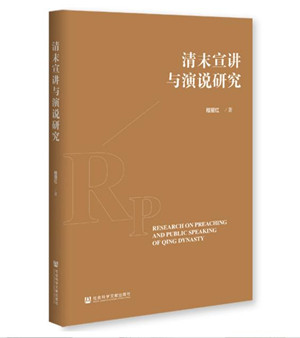Preaching and public speaking in late Qing
Author : YIN YAN Source : Chinese Social Sciences Today 2023-02-16

Research on Preaching and Public Speaking of Qing Dynasty
Research on Preaching and Public Speaking of Qing Dynasty, by Cheng Lihong, dean and professor of the School of Journalism and Communication at Liaoning University, clarifies the development and evolution of verbal communication modes such as preaching and public speaking in the late Qing Dynasty (1644–1911), as well as their profound social and historical connotations.
Preaching and public speaking shaped a new social environment of verbal communication in late Qing in several ways: new styles of speech abandoned the conventional ritual of preaching imperial decree; the identity of the speaker as the main body of oral communication “moved down,” displaying a professional trend; teahouses, theaters, and parks were public spaces with transparency, openness, and participation; direct face-to-face communication formed closer ties between the communication subject and the audience. The new communication environment formed by these changes led people to break down autocracy and acquire intellectual enlightenment and liberation.
The reason why the transformation of verbal communication in late Qing had a social impact was that “the new environment reset ‘sensory thresholds,’ and these ‘sensory thresholds’ in turn changed people’s perspectives and expectations.” Each new media format creates a brand new environment, exerting a comprehensive, profound, and subtle influence on people’s perceptual systems. In late Qing, new-style preaching and public speaking represented such new media, which not only spread the ideas of democracy, freedom, and patriotism, but also broke the shackles of traditional ethics through symbolic communication forms.
Du Tong, an official of the Shandong supervision department at the time, strongly affirmed the role of newspaper interpretation agencies. “In recent years outside Beijing, there set up many special places to interpret newspapers and books, or in other names, with the aim of arousing and enlightening the wisdom of the people. Even vendors and the illiterate were convenient to listen to, cost very little, yet benefited very much.” This piece of historical data clearly indicates the new environment formed by new media.
The abovementioned places created a pervasive local environment. The form of “convenient listening” built an acceptance environment, allowing for equal participation of the audience, and the communication content of “arousing and enlightening the wisdom of the people” created a psychological environment, facilitating its fit into daily life. A new “sensory threshold” thus came into being among the ordinary people, lowering the threshold of the audience’s acceptance of new media. The new media environment, resulting from the changing media of verbal communication, had a new impact on the people and contributed to pushing social enlightenment and modernization in late Qing.
Yin Yan is an associate professor from the School of Media Science at Northeast Normal University.
Ye Shengtao made Chinese fairy tales from a wilderness
Ye Shengtao (1894–1988) created the first collection of fairy tales in the history of Chinese children’s literature...
-
How northern ethnicities integrated into Chinese nation
2023-09-18
-
Mogao caves
2023-09-12
-
Mogao Grottoes as ‘a place of pilgrimage’
2023-09-12
-
Time-honored architectural traditions in China
2023-08-29
-
Disentangling the civilizational evolution of China
2023-08-28
-
AI ethics in science fiction
2023-08-23














 2011-2013 by www.cssn.cn. All Rights Reserved
2011-2013 by www.cssn.cn. All Rights Reserved